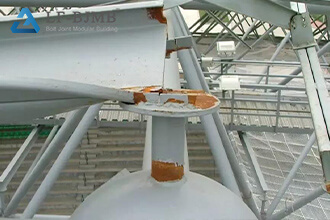+86 177 5193 6871
222, Block B, Diamond International, Guozhuang Road, Xuzhou, Jiangsu, China
When designing steel structures in typhoon-prone areas, the following points need to be considered:
 1. Structural selection: choose the steel structure form with reasonable structure, good stability, and strong bearing capacity. At the same time, avoid adopting a structural form that is easily affected by wind disasters, such as a single-layer solid web beam.
1. Structural selection: choose the steel structure form with reasonable structure, good stability, and strong bearing capacity. At the same time, avoid adopting a structural form that is easily affected by wind disasters, such as a single-layer solid web beam.
2. Wind-resistant design: According to local meteorological data and typhoon characteristics, carry out wind-resistant design for the steel structure, including calculation and analysis of wind load, wind pressure, wind force, and other parameters. At the same time, the adverse effects such as additional load and instantaneous strong wind that the typhoon may bring should be taken into account.
3. Node design: The steel structure node is the key part of the structure, and its strength and stiffness must meet the requirements. In typhoon-prone areas, the node design should pay special attention to the reliability and stability of the connection to prevent the nodes from destroying and leading to the instability of the whole structure.
4. Support system: To improve the integrity and stability of the steel structure, it is necessary to set up a reasonable support system, including horizontal support, vertical support, and inclined support. The arrangement of the bracing system should be based on the structural form and stress situation to ensure the structure’s overall stability and wind resistance.
5. Anti-corrosion and anti-rust: steel structures are susceptible to corrosion and rust during long-term use. In typhoon-prone areas, steel structures are more susceptible to erosion by rain and sea breeze. Therefore, effective anti-corrosion and anti-rust measures should be taken, such as applying anti-corrosion coatings, regular inspection and maintenance.
6. Construction Requirements: During the construction process, construction specifications and safety requirements should be strictly observed to ensure the construction quality. Meanwhile, before the arrival of typhoon season, safety inspection and maintenance of the construction site should be carried out to prevent damage to the construction site caused by typhoons.
7. Emergency plan: To cope with the disasters that may be brought by typhoons, it is necessary to make a perfect emergency plan. The emergency plan should include the early warning mechanism, emergency response procedures, rescue and relief measures, etc., to ensure the disaster can be quickly and effectively responded to.
In conclusion, when designing steel structures in typhoon-prone areas, it is necessary to fully consider the hazards and impacts of typhoons and take effective measures to improve the wind resistance, stability, and safety of steel structures. At the same time, construction management and maintenance should be strengthened to ensure the service life and safety of steel structures.
